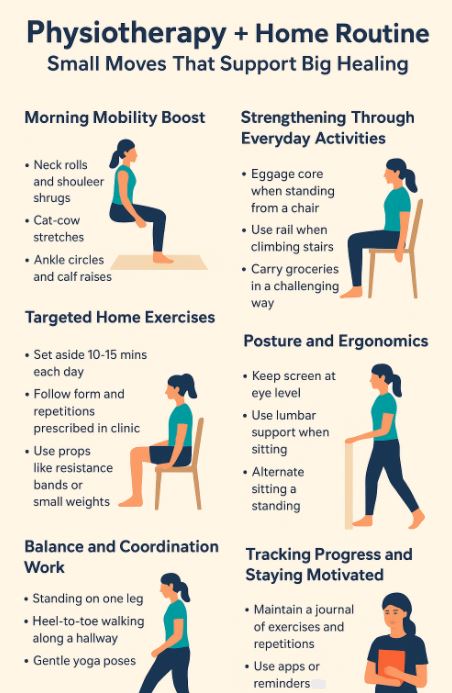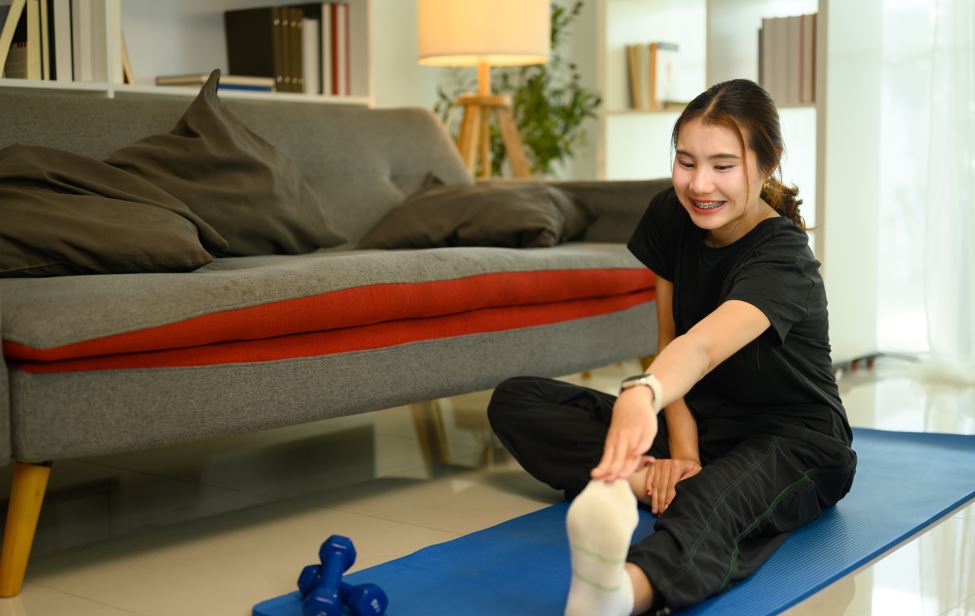Recovery and wellness are not just about what happens during your physiotherapy appointment—they’re about what you do between sessions. Implementing simple, daily exercises at home can significantly enhance mobility, reduce pain, and accelerate healing. Here’s how you can turn small, manageable movements into big results.
Did you know? At Breathe Wellness, physiotherapy doesn’t stop at the clinic. Small, consistent movements you do at home can amplify your recovery, relieve pain, and keep your body functioning at its best. Book your physiotherapy session today to learn how a personalized home routine can complement your treatment.
1. Morning Mobility Boost
How you start your day sets the tone for your body. Gentle stretches first thing in the morning improve circulation, reduce stiffness, and prepare your muscles and joints for the day ahead.
Simple moves to try:
-
Neck rolls and shoulder shrugs to release tension
-
Cat-cow stretches on the floor or bed to mobilize the spine
-
Ankle circles and calf raises to wake up lower body muscles
Doing these stretches consistently can complement core strengthening exercises recommended by your physiotherapist, helping you maintain flexibility and reduce morning stiffness. For more tips on gentle morning mobility routines, see this guide from the Canadian Physiotherapy Association.
2. Strengthening Through Everyday Activities
You don’t need fancy equipment to reinforce your physiotherapy work. Everyday movements—like standing from a chair, climbing stairs, or carrying groceries—can double as strengthening exercises if done mindfully.
How to make everyday movements therapeutic:
-
Engage your core when standing up from a chair to protect your back
-
Use the rail when climbing stairs but push lightly with your legs to build strength
-
Carry groceries in a way that challenges your arms and shoulders without straining
By turning routine activities into mini workouts, you reinforce proper movement patterns, improve joint stability, and support overall recovery.
 3. Targeted Home Exercises
3. Targeted Home Exercises
Your physiotherapist will often prescribe specific exercises for your injury, condition, or mobility goals. Doing them at home is crucial for progress.
Tips for consistency and effectiveness:
-
Set aside a dedicated 10–15 minute block each day
-
Follow the exact form and repetitions demonstrated in clinic
-
Use props like resistance bands, small weights, or even water bottles if advised
For example, if you’re recovering from knee pain, exercises like seated leg lifts, mini squats, or hamstring stretches can be done at home with minimal equipment. Consistency is key: small, daily practice reinforces muscle memory and accelerates healing.
4. Posture and Ergonomics
Your posture and environment affect recovery as much as formal exercises. Spending hours slouched at a desk or on the couch can undo progress from physiotherapy sessions.
Simple adjustments for daily support:
-
Keep your screen at eye level to reduce neck strain
-
Use lumbar support when sitting for extended periods
-
Alternate between sitting and standing if possible
Integrating mindful posture habits with your home routine ensures that muscles and joints stay aligned, reducing pain and tension over time. Learn more about posture and ergonomics here.
5. Balance and Coordination Work
Balance and coordination exercises are often overlooked, but they are essential for preventing falls, improving movement efficiency, and supporting rehabilitation.
Home-friendly exercises:
-
Standing on one leg for 20–30 seconds while holding onto a counter for safety
-
Heel-to-toe walking along a hallway
-
Gentle yoga poses like tree pose or warrior stance
Incorporating balance work into your home routine enhances proprioception—the body’s awareness of position—and strengthens stabilizing muscles, which supports long-term mobility and injury prevention.
6. Recovery and Self-Care
Recovery isn’t just about movement; it’s also about rest, nutrition, and listening to your body. Simple home habits can enhance your physiotherapy results.
Key self-care strategies:
-
Apply ice or heat as recommended by your physiotherapist to reduce inflammation and ease soreness
-
Practice deep breathing or mindfulness to reduce muscle tension
-
Prioritize sleep and hydration to support tissue repair
Combining these practices with your exercise routine ensures that your body heals efficiently and stays resilient over time.
7. Tracking Progress and Staying Motivated
One of the biggest challenges with home routines is consistency. Keeping track of your exercises and celebrating small improvements reinforces motivation and ensures steady progress.
Ways to track your home routine:
-
Maintain a short journal of exercises and repetitions
-
Use apps or reminders to schedule daily movement
-
Celebrate milestones, like increased repetitions, longer hold times, or reduced pain
Tracking progress helps you stay accountable and gives your physiotherapist valuable feedback to adjust your program as needed.
Small Moves, Big Healing
Integrating simple, mindful exercises and habits into your daily life extends the benefits of your physiotherapy sessions. From morning stretches and posture adjustments to balance work and recovery practices, every small move contributes to overall healing. By taking an active role in your recovery at home, you can reduce pain, improve mobility, and maintain long-term wellness.
Physiotherapy is most effective when it becomes part of your daily routine. Learn more about how a personalized plan can support your recovery and overall well-being at Breathe Wellness physiotherapy services

